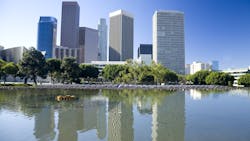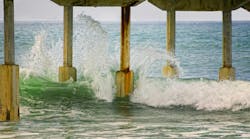Three water advocacy organizations in the Los Angeles region have shared a new report with L.A. County decision makers overseeing the Safe, Clean Water Program, detailing proposed goals for the program.
The report, Vision 2045: Thriving in a Hotter and Drier LA County through Local Stormwater Capture and Pollutant Reduction, was developed by the Natural Resources Defense Council, Heal the Bay, and Los Angeles Waterkeeper.
The organizations say that the report is intended to catalyze county efforts to ensure the Safe, Clean Water Program reaches its goals more quickly and definitively.
The program provides $280 million annually in dedicated funding to increase local water supplies, improve water quality and protect public health through enhanced stormwater capture capabilities. The timing of the release of this document corresponds with the pending LA County Board of Supervisors vote on Dec. 5 to approve the LA County Water Plan that builds on their goal of 80% local water supplies by 2045.
The advocacy organizations’ document identifies specific metrics for reaching interim and long-term targets related to water supply, water quality, environmental justice for disadvantaged communities, and making schools and communities greener throughout the county.
“The voters overwhelmingly supported the Safe, Clean Water Program funding measure in order to help drought-proof the LA region and to clean up our long-polluted rivers, lakes and coastal waters to make them safe for people and aquatic life,” said Dr. Mark Gold, Water Scarcity Solutions Director at Natural Resources Defense Council. “Our groups worked together to develop the Vision 2045 document with numeric targets and milestones that will transform the region into a greener, safer, more climate resilient Los Angeles County if fully implemented.”
The Safe, Clean Water Program, created by Measure W in 2018, is undergoing its first Biennial Review. This assessment process gives LA County a chance to identify what parts of the program are working well and where there are opportunities for improvement.
“The County has done a terrific job in getting this complex and ambitious program off the ground,” noted Bruce Reznik, executive director of LA Waterkeeper. “But without measurable goals identified, it’s hard to know whether we are on track to improve water quality, increase local water independence, and expand access to green space in disadvantaged communities as intended. The Vision 2045 document offers the County specific ideas about how to set those targets and measure progress in an ongoing way.”
Among other goals, the report calls for a target of an additional 300,000 acre-feet of stormwater to be captured and put to use every year by 2045. The document also calls on the county to aggressively reduce water pollution by complying with state deadlines, and ensure that at least 10% of projects in disadvantaged communities that are funded through the program are led by community-based organizations, to ensure robust community involvement.
The vision document also proposes a target of replacing 12,000 acres of impermeable surfaces with new green space by 2045: a nature-based solution that provides recreation, open space, public health benefits and more. It calls for all schools located within the boundaries of state-defined disadvantaged communities to become green schools by 2030, with all LA County schools meeting that target no later than 2045. Vision 2045 also sets a target of developing an outreach plan to actively engage local tribes in program implementation by the end of next year.
The Safe, Clean Water Program is administered by LA County’s Flood Control District under the supervision of the Board of Supervisors. Recommendations for specific updates to program implementation are expected to be presented to the Board of Supervisors in early 2024.






